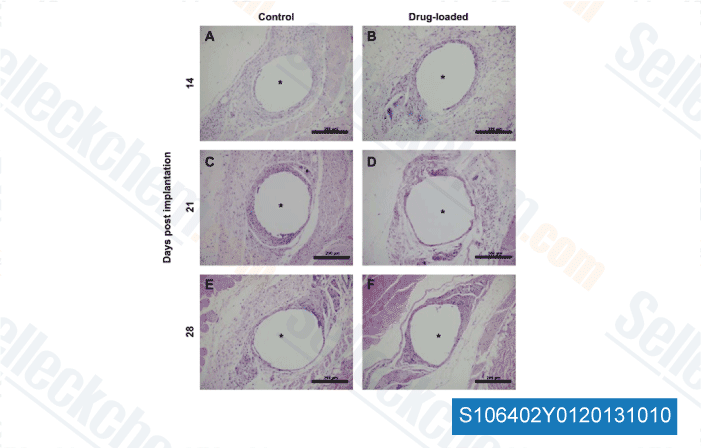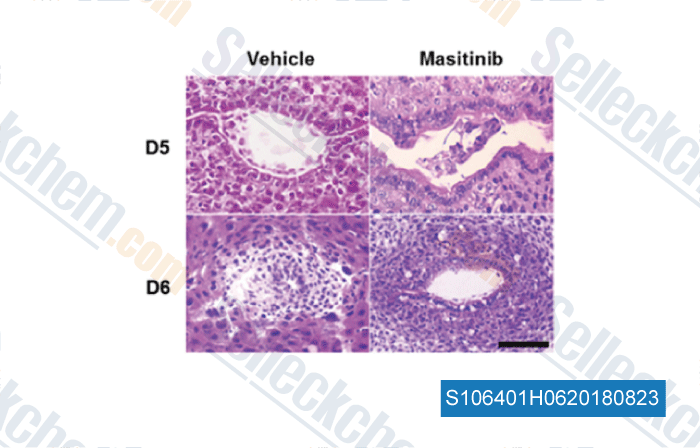|
Toll Free: (877) 796-6397 -- USA and Canada only -- |
Fax: +1-832-582-8590 Orders: +1-832-582-8158 |
Tech Support: +1-832-582-8158 Ext:3 Please provide your Order Number in the email. |
Technical Data
| Formula | C28H30N6OS |
|||
| Molecular Weight | 498.64 | CAS No. | 790299-79-5 | |
| Solubility (25°C)* | In vitro | DMSO | 100 mg/mL (200.54 mM) | |
| Ethanol | 4 mg/mL (8.02 mM) | |||
| Water | Insoluble | |||
|
* <1 mg/ml means slightly soluble or insoluble. * Please note that Selleck tests the solubility of all compounds in-house, and the actual solubility may differ slightly from published values. This is normal and is due to slight batch-to-batch variations. * Room temperature shipping (Stability testing shows this product can be shipped without any cooling measures.) |
||||
Preparing Stock Solutions
Biological Activity
| Description | Masitinib is a novel inhibitor for Kit (c-Kit) and PDGFRα/β with IC50 of 200 nM and 540 nM/800 nM, weak inhibition to ABL and c-Fms. Phase 3. | |||||||||||
|---|---|---|---|---|---|---|---|---|---|---|---|---|
| Targets |
|
|||||||||||
| In vitro | Masitinib is a competitive inhibitor against ATP at concentrations ≤500 nM. Masitinib also potently inhibits recombinant PDGFR and the intracellular kinase Lyn, and to a lesser extent, fibroblast growth factor receptor 3. In contrast, Masitinib demonstrates weak inhibition of Abl and c-Fms. Masitinib more strongly inhibits degranulation, cytokine production, and bone marrow mast cell migration than imatinib. In Ba/F3 cells expressing human wild-type Kit, Masitinib inhibits SCF (stem cell factor)-induced cell proliferation with an IC50 of 150 nM, while the IC50 for inhibition of IL-3-stimulated proliferation is at approximately >10 µM. In Ba/F3 cells expressing PDGFRα, Masitinib inhibits PDGF-BB-stimulated proliferation and PDGFRα tyrosine phosphorylation with IC50 of 300 nM. Masitinib also causes inhibition of SCF-stimulated tyrosine phosphorylation of human Kit in mastocytoma cell-lines and BMMC. Masitinib inhibits Kit gain-of-function mutants, including V559D mutant and Δ27 mouse mutant with IC50 of 3 and 5 nM in Ba/F3 cells. Masitinib inhibits the cell proliferation of mastocytoma cell lines including HMC-1α155 and FMA3 with IC50 of 10 and 30 nM, respectively. [1] Masitinib inhibits cell growth and PDGFR phosphorylation in two novel ISS cell lines, which suggest that Masitinib displays activity against both primary and metastatic ISS cell line and may aid in the clinical management of ISS. [2] | |||||||||||
| In vivo | Masitinib inhibits tumour growth and increases the median survival time in Δ27-expressing Ba/F3 tumor models at 30 mg/kg, without cardiotoxicity or genotoxicity. [1] Masitinib (12.5 mg/kg/d PO) increases overall TTP (time-to-tumor progression) compared with placebo in dogs. [3] The combination of masitinib/gemcitabine shows synergy in vitro on proliferation of gemcitabine-refractory cell lines Mia Paca2 and Panc1, and to a lesser extent on Mia Paca-2 pancreatic tumours in Nog璖CID mice. [4] | |||||||||||
| Features | Potential low side-effect profile. |
Protocol (from reference)
| Kinase Assay:[1] |
|
|---|---|
| Cell Assay:[1] |
|
| Animal Study:[1] |
|
References
Customer Product Validation

-
Data from [Data independently produced by Biomaterials, 2013, 34, 9737-46]

-
Data from [Data independently produced by , , Mol Cell Endocrinol, 2018, 470:75-83]

-
Data from [Data independently produced by , , Invest Ophthalmol Vis Sci, 2016, 57(3):1201-6]
Selleck's Masitinib has been cited by 41 publications
| Crosstalk with lung fibroblasts shapes the growth and therapeutic response of mesothelioma cells [ Cell Death Dis, 2023, 10.1038/s41419-023-06240-x] | PubMed: 37938546 |
| Masitinib Inhibits Hepatitis A Virus Replication [ Int J Mol Sci, 2023, 24(11)9708] | PubMed: 37298659 |
| Development of Masitinib Derivatives with Enhanced Mpro Ligand Efficiency and Reduced Cytotoxicity [ Molecules, 2023, 28(18)6643] | PubMed: 37764425 |
| Development of Masitinib Derivatives with Enhanced Mpro Ligand Efficiency and Reduced Cytotoxicity [ Molecules, 2023, 28(18)6643] | PubMed: 37764425 |
| The IDentif.AI-x pandemic readiness platform: Rapid prioritization of optimized COVID-19 combination therapy regimens [ NPJ Digit Med, 2022, 5(1):83] | PubMed: 35773329 |
| Resistance to PI3κδ inhibitors in marginal zone lymphoma can be reverted by targeting the IL-6/PDGFRA axis [ Haematologica, 2022, 10.3324/haematol.2021.279957] | PubMed: 35484662 |
| EGFR-phosphorylated GDH1 harmonizes with RSK2 to drive CREB activation and tumor metastasis in EGFR-activated lung cancer [ Cell Rep, 2022, 41(11):111827] | PubMed: 36516759 |
| Comprehensive drug response profiling and pan-omic analysis identified therapeutic candidates and prognostic biomarkers for Asian cholangiocarcinoma [ iScience, 2022, 25(10):105182] | PubMed: 36248745 |
| Evaluation of the therapeutic potential of masitinib and expression of its specific targets c-Kit, PDGFR-α, PDGFR-β, and Lyn in canine prostate cancer cell lines [ Vet Comp Oncol, 2022, 10.1111/vco.12817] | PubMed: 35384248 |
| Exploiting polypharmacology to dissect host kinases and kinase inhibitors that modulate endothelial barrier integrity [ Cell Chem Biol, 2021, S2451-9456(21)00303-2] | PubMed: 34216546 |
RETURN POLICY
Selleck Chemical’s Unconditional Return Policy ensures a smooth online shopping experience for our customers. If you are in any way unsatisfied with your purchase, you may return any item(s) within 7 days of receiving it. In the event of product quality issues, either protocol related or product related problems, you may return any item(s) within 365 days from the original purchase date. Please follow the instructions below when returning products.
SHIPPING AND STORAGE
Selleck products are transported at room temperature. If you receive the product at room temperature, please rest assured, the Selleck Quality Inspection Department has conducted experiments to verify that the normal temperature placement of one month will not affect the biological activity of powder products. After collecting, please store the product according to the requirements described in the datasheet. Most Selleck products are stable under the recommended conditions.
NOT FOR HUMAN, VETERINARY DIAGNOSTIC OR THERAPEUTIC USE.
